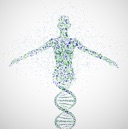 Students store Introductory Biology topics in ‘bubbles’, often unrelated to each other or the world the students inhabit. One challenging area where this happens a lot is mutation–how mutations happen, why mutations have consequences, and even the idea that mutations happen to ‘us.’ One of my favorite articles from the popular press had a title similar to “Blue eyes arose through human ‘mutation’ thousands of years ago”, with the word mutation offset in quotes–to indicate blue eye changes aren’t real mutations? In trying to make the concept more concrete and interesting to students, I’ve accumulated a series of human phenotypes (and primary literature sources) that amuse students while also driving key concepts home. The role of mutation in generating diversity and driving evolution is quietly but steadily made as well.
Students store Introductory Biology topics in ‘bubbles’, often unrelated to each other or the world the students inhabit. One challenging area where this happens a lot is mutation–how mutations happen, why mutations have consequences, and even the idea that mutations happen to ‘us.’ One of my favorite articles from the popular press had a title similar to “Blue eyes arose through human ‘mutation’ thousands of years ago”, with the word mutation offset in quotes–to indicate blue eye changes aren’t real mutations? In trying to make the concept more concrete and interesting to students, I’ve accumulated a series of human phenotypes (and primary literature sources) that amuse students while also driving key concepts home. The role of mutation in generating diversity and driving evolution is quietly but steadily made as well.
Despite some hysteria in movies and the press, being a mutant is the norm. You picked up something like a dozen mutants just in the process of your parents making the copies of their DNA that became your genetic inheritance. Due to the large stretches of inconsequential DNA you have, as well as the ability of the genetic code to undergo some edits without changes to meaning, a lot of the differences between you and everyone else simply don’t manifest.
On the other hand, some mutations in ‘recent’ history (the last 10,000 years in some cases) have changed who we look for on dating sites, what we can eat for dinner, and how we see the world. This post will take a brief look at some noteworthy human mutations and phenotypes that you may or may not partake of, and provide links for further explorations.
Blue eyes
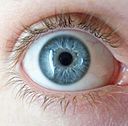
This is an engaging topic because it ties in the relevance of DNA sequencing and genotyping in their lives–it’s how I know that they all got their blue-eyed allele at the same place (caveat: the original study did not have the broadest possible sample size or distribution, so a better statement is “all blue eyed folks in the published work had the same allele”).
ThinkBio resources for the blue eyes and descent lecture.
Digesting milk
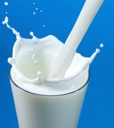 This one is a tremendously fun discussion to lead regarding human mutations and phenotypes. For many folks of European descent, drinking milk seems as natural as breathing. The first challenge one is communicating that it’s not. First off is the required foundational assertion that lactose is found almost exclusively in milk. My efforts to trigger this idea by asking if anyone knows common names for lactose fail, I guess because ‘milk sugar’, a term I learned in my youth, is no longer a thing. But once this idea is established/accepted, the fun can begin. My general Q & A runs something like the following:
This one is a tremendously fun discussion to lead regarding human mutations and phenotypes. For many folks of European descent, drinking milk seems as natural as breathing. The first challenge one is communicating that it’s not. First off is the required foundational assertion that lactose is found almost exclusively in milk. My efforts to trigger this idea by asking if anyone knows common names for lactose fail, I guess because ‘milk sugar’, a term I learned in my youth, is no longer a thing. But once this idea is established/accepted, the fun can begin. My general Q & A runs something like the following:
- Suppose you’re a normal monkey. What would be the sources of milk in your life? [mother]
- How long would that last [until weaned–we’re talking months here]
- What purpose would be served by making enzymes to digest milk sugar/lactose for the rest of your flippin’ life? [none]
- So… if natural selection were favoring folks didn’t waste time making stuff they didn’t need, what would you predict to be the expression curve for lactase? [off by age 1 or 2]
- So your prediction for NORMAL primate adult ability to digest lactose would be…? [they can’t]
- So… what is the milk you’re buying at the store? [ewww…. the product of other species’ lactation!]
- And who do you think came up with that idea? [some ancestral human being that decided sucking on the teat of another species was a good idea]
- ==>Side excursion: it’s a brilliant idea, though–cows, camels, goats convert grass, which we cannot eat, into mobile meat and/or renewable high-value nourishment.
- So when did digesting milk become a good idea? [When we started farming & domesticating animals]
- So… who’s a mutant?
The fun of this exploration continues in that unlike blue eyes, there are several different alleles associated with lactase persistence (LP, the formally correct name for the mutant condition of adult ability to digest lactose), demonstrating that the idea and accompanying mutation arose several times (I think it’s worth pointing out that the mutation must arise randomly and periodically and be available to reward the milk drinking attempt, unless yogurt making came first–I’m ignorant on that count). This gets even cooler when you toss in the fact that by having the molecular biologists hook up with historians and paleontologists and archaeologists (I may be mis-attributing a specialty here) we can ‘blame’ certain alleles on camel vs. cow domestication.
My efforts to accumulate teaching resources can be found here; make sure to check out the references table.
Pale skin
It’s pretty well accepted that humans began our rather hairless development into Homo in Africa, and it’s clear that ancestral populations there are dark-skinned. So where did lighter skin come from and why?
thinkBio resources (papers, lecture materials) are here, but the brief story is that skin is darkened by melanin, a pigment that directly absorbs UV light and converts its energy to heat. This is not a bad plan if you’re bathed in UV light have a genetic material where meanings change or are lost upon UV exposure.
But there’s another side to the coin–our ability to synthesize vitamin D depends critically on the energy of UV light for one of the steps. So as human populations move away from the equator, the urgency of of UV protection becomes less, and the need to permit more light into the skin to promote vitamin D synthesis becomes greater.
There’s lots more to the story, such as why Inuit peoples of Alaska get to retain their dark skin (a fish diet is rich in vitamin D) and why Nordic populations may be lightest of all (the ‘Atlantic conveyor’ ocean current sweeps by, making for milder winters, an ability to grow [vitamin D-poor] grains as a major source of calories, and thus no vitamin D in the diet and little UV in the sky with which to synthesize vitamin D.
Distinguishing Red & Green
Human detection of light is a fascinating collection of tales relating many themes appropriate to an Intro Bio course. We detect wavelength of light at 3 points in the spectrum, our so-called red, blue and green opsins. However, opsin proteins themselves are not the photon-grabbers; it’s the retinal molecule each holds… though the retinal molecule is identical between all three–tuning is achieved because the retinal is in a different local environment (= partially different amino acid sequences). And retinal is derived from vitamin A, hence the famous “eat your carrots to see better” from dinner tables everywhere.
Adding in phylogenetic construction via gene sequences makes the story even more interesting. A first insight into “We’re not at the ‘top’ of the phylogenetic tree’ comes when we note that many animals have more opsins than we do, and thus have access to a richer set of visual distinctions than we can make (much as full-color capable ‘trichromatic’ individuals see a wider array of color than red-green colorblind dichromatic do (FYI, a deeper discussion and links to interactive resources are available from the thinkBio site).
The tale takes a dramatic twist when it becomes clear that our ancestors had this capability… and gave it up. The short form of the story is that ‘when dinosaurs ruled the earth’ our ancestors skulked about in tunnels and scampered about after dark–where maximum light detection was the priority, and presumably individuals that lost a colored opsin gene dedicated more of their retinas to night vision (a 4th opsin protein) had the advantage. As with so many things, investing in ONE option (sensitive seeing) comes at the expense of another (distinguishing colors) because there’s only so much room for detectors!
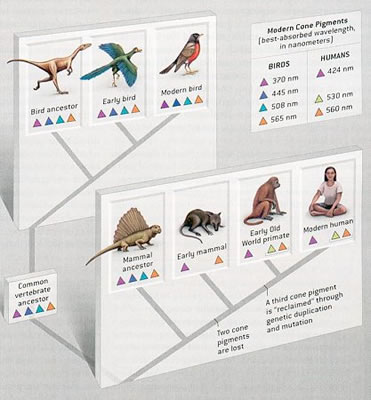
Image courtesy of Hayden-McNeil publishing
The is even more interesting with DNA sequences, which reveal how (some) primates ‘got our groove back’–genetically ‘re-discovering’ the ability to distinguish red from green.
Directly contradicting the silly “there is no mechanism by which new information can arise through mutation” claim, the following sequence of mistakes re-gifts us with the ability to distinguish red from green:
- Duplication of a primordial ‘red ‘opsin (it’s a ‘red’ because it absorbs further into the red, akin to that of other organisms)[aside: at the time, it was the ‘non-blue’ opsin, as there wasn’t a ‘green’ to be contrasted with!]
- Further mutations in one of the two homologs causing it to ‘tune’ toward shorter wavelengths–more green
How do we know that our “green is a red” as opposed to “we never lost green” or “our green is a stolen or re-discovered green”? Very simply, if we compare DNA sequences, our green opsin DNA sequence is MORE SIMILAR to that of our red opsin than it is to the green opsins of anything else. Indeed, it’s more similar to our red than our red is to the red opsin of some other organisms.
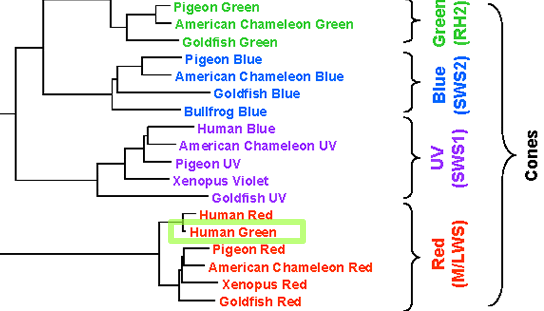
So… while our LOOOONG ago ancestors had color vision, our less-long-ago (proto-mammal) ancestors couldn’t… and our ‘relatively recent’ ancestors copied and decayed a red opsin gene, thereby discovering a green-reading opsin… and thus discovering the ability to differentiate wavelengths in the red-green end of the spectrum.
failing to!
This one is relatively obvious and well-known, but there are two links that’s I think are valuable to point out.
- Since the ‘green gene’ arose through erroneous duplication of the red, its location is right next door–meaning that meiosis is going to spontaneously generate NEW cases of R-G colorblindness ‘periodically’
- Since the genes are located on the X, there is inevitably much greater frequency of RG colorblindness in men
Resisting malaria
Sickle cell anemia
Is generally thought of as a flat-out curse… which it certainly is for homozygotes. But how to account for its prevalence in folks of African descent? There are deep insights into evolution’s means of problem-solving here. In the immortal words of Donald Rumsfeld
you go to war with the army you have, not the army you might want or wish to have at a later time
Paraphrased, if you have a solution to the greatest scourge of humankind… ever, it may be a good thing regardless of the cost. There’s more on t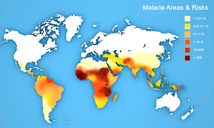 hese ideas in my ‘Evolution‘ post, but briefly, being heterozygous for the sickle cell allele invokes little downside from sickle cell anemia, while providing significant resistance to malaria. And if you look at ancestral populations, the malaria map shown is almost isomorphic to a ‘frequency of sickle cell alleles’ map. And research backs up the correspondence between sickle cell genotype and resistance.
hese ideas in my ‘Evolution‘ post, but briefly, being heterozygous for the sickle cell allele invokes little downside from sickle cell anemia, while providing significant resistance to malaria. And if you look at ancestral populations, the malaria map shown is almost isomorphic to a ‘frequency of sickle cell alleles’ map. And research backs up the correspondence between sickle cell genotype and resistance.
duffy
I’m not as knowledgeable here, but the story has similarities to sickle cell; I’ll just deposit this reference.
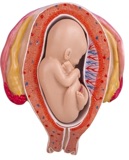 Growing up in a placenta
Growing up in a placenta
While covered in prior posts on hemoglobin and evolution, the Big Idea is worth reiterating. Mammal fetuses produce a variant hemoglobin (that arose through the same duplication-mutation cycle as the opsins treated above) that more aggressively courts oxygen. Thus in the placenta at the mother’s blood::fetal blood interface, oxygen exchange effectively takes place, and the fetus is able to get a richer oxygen supply than if it were sporting an identical hemoglobin and the O2 fight were ‘fair’.
You’re a tall dutchman
Actually, in this case we’re not talking about new mutations, but rather collecting and increasing the frequency of alleles that give rise to greater tallness. But that’s the formal definition of evolution–a change in allele frequency over time. Obviously, a NEW allele that becomes prevalent has had a whopping increase in frequency, but any change in any allele is legit. So this one actually fits better under a topic heading of “You might be evolving if…”
http://news.sciencemag.org/biology/2015/04/did-natural-selection-make-dutch-tallest-people-planet

